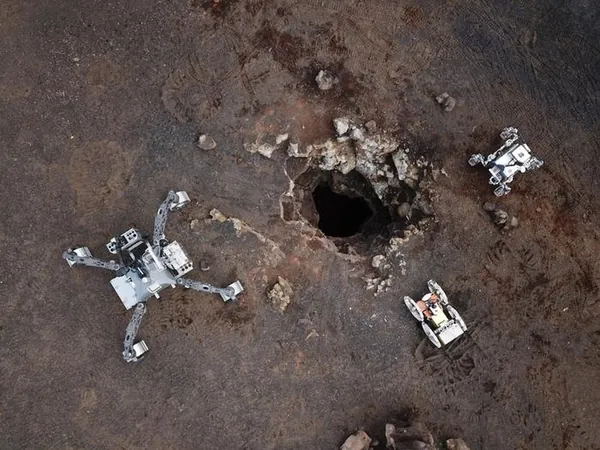
Unveiling the Moon: A Trio of Robots Set to Explore Lunar Caves!
2025-09-12
Author: Yu
Exploring the Moon’s Hidden Caves!
Space exploration is thrilling but comes with immense challenges—especially on the Moon, where powerful solar radiation and extreme temperatures create a hostile environment.
The Moon experiences temperature swings from scorching highs of 121°C to bone-chilling lows of -146°C, with some polar regions plunging into a relentless -240°C freeze. The total absence of atmosphere means micrometeorites relentlessly bombard the surface at incredible speeds of up to 70 km/s, with over 10,000 kg impacting daily!
The Safety of Astronauts Comes First!
Given these severe hazards, finding refuge is essential for astronauts. Recent studies suggest that ancient lava tubes, formed during volcanic eruptions, could provide much-needed shelter. These tubes feature openings called skylights, visible in orbital images, that could serve as entrances for exploration.
Meet the Robotic Trio!
A groundbreaking team of European researchers has created a trio of robots adept at navigating these lunar caves. Their work, presented in a recent issue of Science Robotics, explores how these robots could work together to assess the caves' viability as habitats for future astronauts.
The innovative robots were tested on Lanzarote, a volcanic island in Spain, where they successfully simulated their lunar mission. With different capabilities, the robots aim to explore the caves in a series of carefully planned phases.
How the Robots Will Work Together!
The robotic team consists of three unique machines: SherpaTT, Coyote III, and LUVMI-X. SherpaTT acts as a hybrid explorer and anchor, while Coyote III, a nimble wheeled rover, ventures into the depths of the lava tubes. LUVMI-X works alongside SherpaTT to map out the area.
The mission is divided into four phases: mapping the entrance, deploying a high-tech sensor into the cave, Coyote III rappelling down, and then conducting a detailed 3D exploration.
Successful Tests Point to Great Potential!
Initial tests conducted earlier this year showed promising results across all phases. The robots successfully generated a detailed map of the cave entrance and explored the skylight, gathering essential data that could pave the way for future human missions.
Applications Beyond the Moon!
This robotic trio isn't just limited to lunar exploration. The research also opens avenues for similar missions on Mars, where lava tubes could offer protection against radiation and meteorite impacts as well. The potential for exobiological discoveries adds another layer of significance to these missions.
A Future of Autonomous Exploration!
The researchers emphasize that using an autonomous robot team is the most efficient and safe method for exploring difficult-to-access extraterrestrial lava caves. While their findings are encouraging, they acknowledge that further studies are essential to adapt this mission concept for real planetary exploration scenarios.
This ambitious project is set to change the way we think about lunar and Martian exploration, potentially providing the vital shelters astronauts need for their journeys into the cosmos!




 Brasil (PT)
Brasil (PT)
 Canada (EN)
Canada (EN)
 Chile (ES)
Chile (ES)
 Česko (CS)
Česko (CS)
 대한민국 (KO)
대한민국 (KO)
 España (ES)
España (ES)
 France (FR)
France (FR)
 Hong Kong (EN)
Hong Kong (EN)
 Italia (IT)
Italia (IT)
 日本 (JA)
日本 (JA)
 Magyarország (HU)
Magyarország (HU)
 Norge (NO)
Norge (NO)
 Polska (PL)
Polska (PL)
 Schweiz (DE)
Schweiz (DE)
 Singapore (EN)
Singapore (EN)
 Sverige (SV)
Sverige (SV)
 Suomi (FI)
Suomi (FI)
 Türkiye (TR)
Türkiye (TR)
 الإمارات العربية المتحدة (AR)
الإمارات العربية المتحدة (AR)